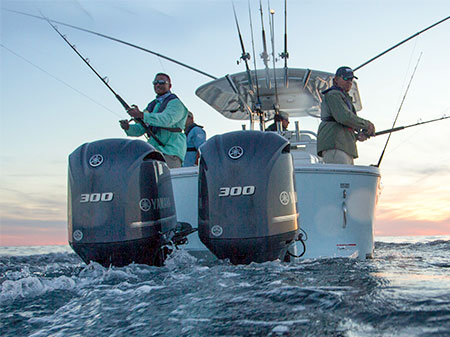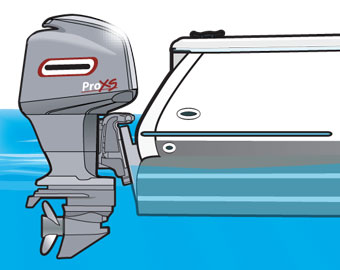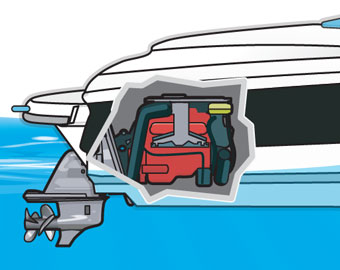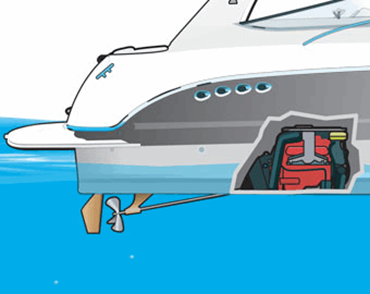Which engine is best for my boat?

Power boats come in many types and sizes and so do your engine choices. Outboard, stern drive or I/O and jet are common choices. Although stern drive has been historically more popular worldwide, outboard power has grown immensely as their horsepower range has increased and their weight decreased. Why is that important? We’ll discuss that and much more as we discover the pro’s and con’s of marine power choices below…
For our customers in Florida, quiet, easy to service, and functionality are all very important consideration in choosing your power. Another equally important consideration is corrosion resistance due to our salt water environment.
OUTBOARDS

A great match for saltwater, outboards create additional room in the main seating area, or “cockpit”, and storage space by positioning the engine behind the back panel of the boat, also called the “transom”. Outboards can also be fully lifted, or “trimmed”, out of the water, and come in a wide variety of horsepowers up to almost 500! They are smaller and lighter than stern drives but do interfere with the use and accessibility to the rear of the boat. Generally speaking, outboards do allow access to more shallow water which comes in handy in Florida.
Outboard Motor Benefits
- Lighter weight
- Best when boat is stored floating in the water
- Best accessibility for service
- Easiest to replace
Outboard Motor Negatives
- LOL, there really aren’t any.
STERN DRIVE or INBOARD / OUTBOARD (I/O)

Stern drive power is the go-to engine for most bowrider and sport boat manufacturers. Stern drives tuck the engine below a lounge area (sunpad) or the engine box at the back of the boat, and allow for an easily accessible and an uninterrupted swim platform. The swim platform / rear lounge combination are awesome when anchoring at a beach or secluded island. Stern drives are in some cases are quieter and in most cases handle better than outboards due to their lower center of gravity. They do weigh a bit more than outboards so naturally will cause the boat to draw or require more water depth to float. It’s OK though because the extra water needed is only an inch or two.
An important note to consider… Some stern drive manufacturers offer fresh water cooling which is a system that does not allow salt water into the engine for cooling. This protects the engine from corrosion and dramatically increases the longevity of the engine. Because stern drives in cruisers and bowriders/sport boats offer the best accessibility to the rear of the boat they are an excellent choice in these applications.
Stern Drive or I/O Benefits
- Best access to rear of boat and water for swimming or water sports
- Typically quieter
- Lower center of gravity for better control and handling
- More aesthetic appearance
- Better fuel economy in most cases
Stern Drive Negatives
- A bit heavier
- Draw a bit more water
JET POWER

Jet power has also made inroads into the marine power market. Jets have no exposed propeller, relying instead on an enclosed impeller and jet nozzle to deliver the engine’s thrust. Jets typically can venture into shallower waters, boast rapid acceleration, and feature nimble handling. They also offer a clean, uninterrupted transom ideal for fishing. They do consume more fuel the outboards or stern drives and are often a bit louder especially at mid to high speeds.
Jet Power Benefits
- Lightest weight of all engine choices
- Smallest overall package size
- Lower cost
- Can run is shallow water
Jet Power Negatives
- Very loud at most speeds.
- Burns much more fuel than an outboard or stern drive.
- Like a giant vacuum cleaner, they suck things into the jet which often cause damage.
- Vague handling and steer backwards in reverse.
- Will not steer without power. This is particularly concerning since most people when headed toward something they don’t want to impact they instinctively cut power which renders a jet marine engine unable to fully steer.
INBOARD POWER

The traditional inboard, sometimes called a direct drive, positions the engine in the center of the hull to help maintain a level running attitude. The driveshaft passes through the hull and connects the engine to a fixed propeller. Steering is accomplished via a movable rudder, located farther back from the propeller blades.
V-Drive is a variation on the inboard theme. The engine is positioned toward the back of the boat, or the “stern”, freeing up space in the main seating area, or “cockpit” and adding weight to naturally boost the boat’s wakes. The driveshaft runs forward to a v-shaped linkage, where it reverses direction and exits the hull to the fixed propeller. A steerable rudder, farther back from propeller, controls the boat’s direction.
Inboards are often the popular choice for ski and wake boats however, they are not the best choice for coastal saltwater boating. They require deeper water to run and therefore make it difficult to access shallower water areas such as islands and beaches.
Inboard Motor Benefits
- Engine placement for more level attitude while running
- Largest wake
- V drive option allows engine to be mounted in stern.
Inboard Motor Negatives
- Slower top speeds
- Draws more water to run
- Little to no steering control in reverse.
